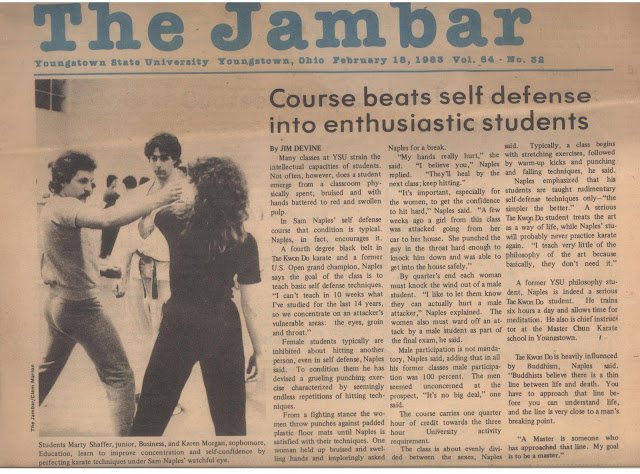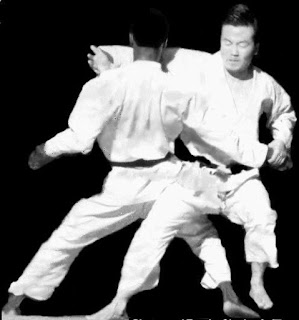 |
| Chating with Supreme Grandmaster Kim Ki-whang in Pittsburgh. |
When I think about it I am humbled and honored to have been able to say that I knew
Supreme Grandmaster Kim and considered him a friend. In fact he often looked out for me at tournaments and I would co-ordinate
THE EAGLE CLASSIC his tournament every June with my partner in crime
Grandmaster Stepan and his amazing student
Grandmaster James Roberts, Jr. who continues to teach Kim's system in the Washington DC area.
FRIENDSHIP BASED UPON AN ARREST
The reason that
Supreme Grandmaster Kim was so kind to me was his relationship to my Sabam (master instructor)
Supreme Grandmaster Chun Kae-bae. Their friendship began in a quite interesting way. At some taekwondo event, probably here in America,
Supreme Grandmaster Kim was talking about one of his best friends a
Moodukkwan master that he use to train with in Korea. My instructor
Supreme Grandmaster Chun overheard this conversation and interjected:
"He's your friend? I arrested him!"
So the story goes that
Supreme Grandmaster Kim's friend was AWOL from the military and they got a tip that he was hiding up in some mountain dojung that the
Moodukkwan men would train in on the weekends. Because this man was a well known
Tangsoodo man in Korea, the police were afraid to arrest him, so someone in charge decided that
Chun Kae-bae,
Korean National Police Force Chief Taekwondo Instructor and Coach of the Police Force Taekwondo Team [which included
Supreme Grandmaster Park Dong-keun (
Grandmaster Gerry Robbins' of
THE OFFICIAL TAEKWONDO HALL OF FAME's instructor),
Supreme Grandmaster Ahn Dae-sup and many others] would capture and bring in this man.
So to make a long story short Supreme Grandmaster Chun arrived at the mountain Dojung. He said: "I cannot go back without you,
NO CHOICE, if you choose to resist, both of us will be injured, maybe one of us will die." The master knowing that there was no way out surrendered. Well as the press has been known to do, they turned this event into a battle worthy of a Bruce Lee movie and
Supreme Grandmaster Chun became a hero. When
Supreme Grandmaster Kim realized who
Supreme Grandmaster Chun was they instantly connected and became the best of friends.
My relationship with Supreme Grandmaster Kim
I've mentioned before that due to naivete and miss-understanding I broke down the boundary between American black belts and the Korean masters by sitting down at the Masters' table in Charleston West Virginia at Supreme Grandmaster Kang Sok-ho's tournament. It was at this tournament that Supreme Grandmaster's Kim Il-joo and Supreme GrandmasterKim Ki-chung began teaching me to co-ordinate tournaments. From this point on I began to run tournaments all over the northern part of the country including the legendary S. Henry Cho ALL AMERICAN OPEN TAEKWONDO TANGSOODO KARATE KUNGFU CHAMPIONSHIP in THE FELT FORUM OF MADISON SQUARE GARDEN in New York City.
At every tournament the masters would welcome then usher me quickly to the microphone. When Supreme Grandmaster Kim Ki-whang saw what I and my cohort Grandmaster Charles Stepan were doing, he started chastising all of the other masters: "Look what K.B. Chun's students are doing, why your black belts no help?" Of course Supreme Grandmaster Chun loved hearing these stories from the other grandmasters.
KIM KI-WHANG THE 7TH FATHER OF TAEKWONDO?
Having done extensive research on the history of Taekwondo and the four era's before the creation of Kukki Taekwondo and the World Taekwondo Federation. The founders of the five original kwan's (schools): Whang Ki, of the Moodukkwan; Rho Byung-jik of Songmookwan; Lee Won-kuk of the Chungdokwan; Yun Byung-in of the YMCA Kwonbup Bu; and Chun Song-sup of the Yunmookwan Kongsoodo Bu (my style). With the exception of Whang Ki, who trained in China and probably with Gogen Yamagushi founder of Japanese Goju in China, all of the founders trained in Japan.
Lee Won-kuk, Rho Byung-jik and Chun Song-sup studied under Gichin Funakoshi founder of Shotokan in Tokyo. Yun Byung-in and Dr. Yun Kwae-byung who would replace Chun Song-sup after his disappearance during the war studied with
Toyama Kanken at Nihon University. All of the early fathers had a karatedo background.
So did
Supreme Grandmaster Kim Ki-whang. It is well known that Kim was a student of Okinawan master
Toyama Kanken and that he was the first Korean to be Captain of the Nihon University Karate Team. When he joined the club he asked if he had a chance to make it to the top of the team. Master Toyama replied:
"I don't care what someone's race is, only how hard he works." Supreme Grandmaster Kim Ki-whang outworked all of the other team members and in fact was called
Typhoon because of his amazing way of nonstop attacking.
Supreme Grandmaster Kim Ki-whang did not create his own kwan in Korea!
I believe that it was in this same spirit, the spirit of Toyama Kanken who he so admired to purposely not create his own style but to just keep teaching the principles of MooDo (the martial arts) as he learned it from his master. In fact Supreme Grandmaster Kim Ki-whang, though a member of Supreme Grandmaster Whang Kee's Moodukkwan, was not a student of Supreme Grandmaster Whang Kee.
 |
| Anne and James Roberts |
Supreme Grandmaster Kim Ki-whang upon his return to Korea was looking for a dojung where he could train hard and someone told him: Those Moodukkwan guys work really hard. So he joined to have a place to practice what he had learned from Master Toyama Kanken, a place where he could contribute his knowledge.
After
Supreme Grandmaster Kim Ki-whang's move to America he joined Taekwondo organization, though he continued to teach the arts of Itosu and Toyama Kanken. His successor
Master James (Jimmy) Roberts and his wife Anne Roberts continue this tradition even today. Anne and Jim Roberts are pictured with my instructor
Supreme Grandmaster Chun Kae-bae upon their induction into the BRUCE LEE LEGENDS OF HONOR HALL OF FAME in Columbus. Jim and Anne also accepted the award for
Supreme Grandmaster Kim Ki-whang who posthumously was inducted.
It is pretty well accepted that
Supreme Grandmaster Kim Ki-whang was the creater of the "Ax Kick" which was made famous by his two amazing fighters
Grandmaster Michael Warren and
Grandmaster Albert Cheeks. His list of students looks like a who's who list of taekwondo in America, including
Supreme Grandmaster Richard Chun In-moon, Grandmaster Chuck Norris, Grandmaster Mitchell Bobrow, Owner of OTOMIX, George Thanos, and Pat E. Johnson (judge, stunt coordinator and actor). Marshall Collins, Marcella Byrd, John Bussard, John Critzos
So though
Supreme Grandmaster Kim Ki-whang did not start his own
kwan, his focus was upon teaching the art he learned and developing the
new art of Taekwondo into the world wide phenomenon that it has become.
It is because of this and the quality of his students, and his teaching as well as his developments in sparing that I believe he should be considered one of the FATHERS OF TAEKWONDO.
















